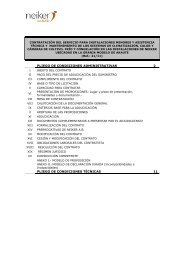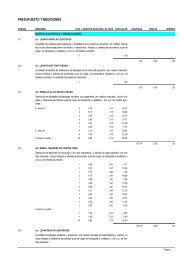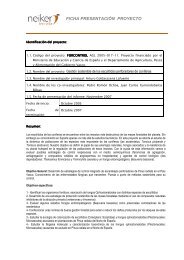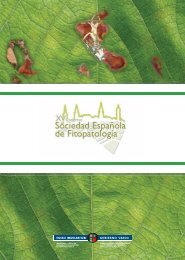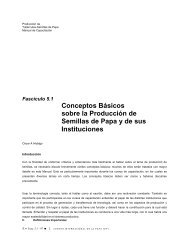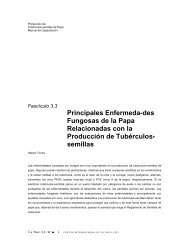The History of Potato (Solanum tuberosum L.) Research in ... - Neiker
The History of Potato (Solanum tuberosum L.) Research in ... - Neiker
The History of Potato (Solanum tuberosum L.) Research in ... - Neiker
Create successful ePaper yourself
Turn your PDF publications into a flip-book with our unique Google optimized e-Paper software.
<strong>Potato</strong> <strong>Research</strong> (2006) 49: 19–25 23<br />
Table 3 Varieties registered <strong>in</strong> Spa<strong>in</strong> between 1979 and 2003.<br />
Variety<br />
Cross<br />
Arene<br />
Desirée Baraka<br />
Asun<br />
Kennebec Palogán (Allerfrüheste Gelbe)<br />
Ayala<br />
Alda Zubeldia<br />
Edurne<br />
LT-1 Buesa<br />
Gorbea<br />
V2 Asun<br />
Idoia<br />
Serrana Gloria<br />
Iker<br />
Alda Blanka<br />
Inca<br />
Spunta Aracy<br />
Isla<br />
Spunta Aracy<br />
Mayka<br />
Avenir AN66-42<br />
Mikel<br />
Palogán (Allerfrüheste Gelbe) Kathad<strong>in</strong><br />
Montico<br />
Alda Rosalie<br />
Nagore<br />
Desirée Baraka<br />
Nerea<br />
Kennebec Baraka<br />
Zadorra Onda 81035/02<br />
Zar<strong>in</strong>a<br />
CIP 324/04 Cascade<br />
Zela<br />
Fanal HT-2<br />
Zepa<br />
CIP 324/04 Cascade<br />
Zorba<br />
CIP 312/35 Carola<br />
Zunta<br />
Palogán (Allerfrüheste Gelbe) Erdgold<br />
In the 1960s epidemiological work was carried out on PLRV transmission (Pérez<br />
de San Román, 1963) and some North American varieties were freed from PVX and<br />
PVS by comb<strong>in</strong><strong>in</strong>g thermotherapy and meristem culture (García-Orad and Pérez de<br />
San Román, 1971), under a collaborative agreement with the USDA. For several<br />
reasons, work related to genetics and ecology was gradually abandoned at the EMP,<br />
and <strong>in</strong> the 1970s only the virology and basic seed sections rema<strong>in</strong>ed.<br />
Third Period (1979–2004)<br />
In 1979, Spanish agricultural research was regionalised and the Basque Government<br />
took over the Station. A new generation <strong>of</strong> scientists was brought <strong>in</strong> to re<strong>in</strong>vigorate<br />
some activities, such as genetic breed<strong>in</strong>g, and to start new ones, such as tissue<br />
culture, nematology, pathology and serology. <strong>The</strong> breed<strong>in</strong>g objectives set were early<br />
maturity, yield and resistance to the ma<strong>in</strong> diseases, <strong>in</strong>clud<strong>in</strong>g late blight (Phytophthora<br />
<strong>in</strong>festans), leafroll (PLRV) and virus Y (PVY).<br />
A germplasm bank, conta<strong>in</strong><strong>in</strong>g both commercial varieties and advanced clones,<br />
was created <strong>in</strong> order to provide enough genetic variability for the crosses <strong>in</strong> the<br />
breed<strong>in</strong>g programme. Sheep and forestry breed<strong>in</strong>g was <strong>in</strong>troduced at the Station,<br />
which changed its name to CIMA (Centro de Investigación y Mejora Agraria,<br />
Agricultural <strong>Research</strong> and Improvement Centre). Collaboration with CIP was<br />
established at this time and CIMA researchers attended the 9th Triennial EAPR<br />
Conference <strong>in</strong> Interlaken, <strong>in</strong> 1984. CIMA itself organised an EAPR Agronomy<br />
Section Meet<strong>in</strong>g <strong>in</strong> 1989.<br />
In this third period, the ELISA technique was adopted very early for virus<br />
detection, <strong>in</strong> collaboration with Mariano Cambra from IVIA (Valencian Institute



